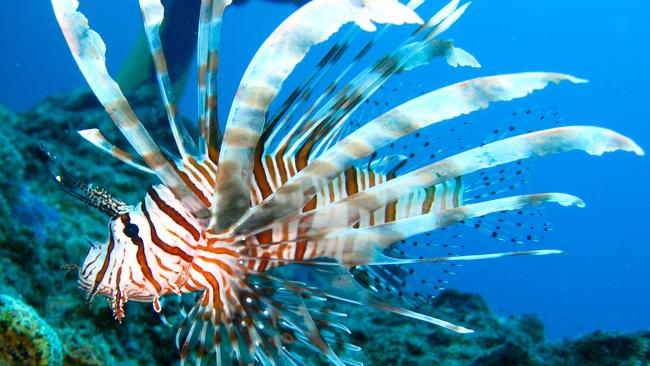James Cook University reviews ex-student’s ‘fishy’ findings
Publishers lapped up JCU marine researcher Oona Lonnstedt’s work on the Barrier Reef. But fellow scientists began to smell a rat.

A collage of 50 lionfish was supposed to dampen questions over concerns around the academic rigour of former star James Cook University research student Oona Lonnstedt. Instead, the colourful photograph has prompted only more questions.
According to colleagues, Lonnstedt, who now lives in Sweden, no longer wants to be contacted about her research and, in fact, has abandoned her career in science. What she has left behind is a test case of how the science community deals with concerns about alleged malpractice when they are raised.
Veteran marine scientist Walter Starck, who received a PhD in marine science from the University of Miami in 1964, says the Lonnstedt affair is symptomatic of a new era.
Starck says generations of researchers have been schooled in a culture wherein threats to the Great Barrier Reef are an unquestionable belief from which all evidence is interpreted.
“She (Lonnstedt) got into the ocean acidification and global warming and the effect CO2 was going to have on the behaviour of marine animals and she started publishing,” Starck says.
“Immediately the publishers lapped it up. As a graduate student she managed to get as much published in one year as most professors do in a decade.”
Lonnstedt’s work is now being picked apart.
JCU says it has appointed an independent panel to investigate the lionfish study and remains “committed to the highest standards of ethical research”.
“The university takes seriously any allegation that a staff member or student has acted contrary to those standards,” a university spokesman says.
“An external panel will investigate research conducted by Oona Lonnstedt at JCU to determine whether there has been any research misconduct.”
Critics say JCU has been quick to talk but slow to act.
When concerns over Lonnstedt’s work were first raised in December 2017, JCU said “the university intends to review the PhD examiners’ report and determine whether any further investigation is required”.

In May last year, JCU said it was establishing an external panel of experts to investigate.
This week, in response to questions from Inquirer, JCU said: “Membership of the external panel has been finalised. Panel members have accepted the role but have not yet been formally appointed.”
The lionfish affair was first raised when the prestigious journal Biology Letters confirmed it was investigating a discrepancy in the number of lionfish obtained by Lonnstedt at her research facility on Lizard Island in Queensland and the dozens of specimens supposedly used in her experiments.
The Biology Letters investigation followed a finding of “scientific dishonesty” about a 2016 research project conducted by Lonnstedt, this one in the Baltic Sea and showing small fish preferred to eat small pieces of plastic, less than 5mm in diameter, than their normal food, and this made them grow slowly and more likely to be eaten by predators.
Lonnstedt’s paper on the microplastic research was published in the journal Science but was retracted after an investigation by Sweden’s Central Ethical Review Board raised the possibility that some of the research described “was not conducted”. Although Lonnstedt and her co-author still strongly defend the paper, they say they decided to retract it. “Science has to rest on solid ground and the results of this study, even if they are correct, will not be trusted as long as a suspicion of misconduct remains,” they said in a statement to the journal Nature.

Before the microplastics study, Lonnstedt had been one of JCU’s most prolific authors before finishing her PhD studies at the Australian Research Council Centre of Excellence for Coral Reef Studies, publishing many high-profile papers on fish behaviour. One claimed that when damselfish live in degraded corals, which may be caused by climate change, they lose some of their sense of smell and become “fearless” and more subject to being eaten by predators. In another paper she looked at the effect of high concentrations of carbon dioxide on the ability of damselfish to respond to predators. Lonnstedt found they were likelier to be eaten by predators. Three of the most well-publicised environmental threats — reef degradation from climate change, changes in ocean’s acidity or alkalinity from carbon dioxide and the impact of microplastics — all, according to Lonnstedt’s work, cause little fish to be eaten by predators.
One paper has been proved to be incorrect because it was found Lonnstedt did not have time to undertake the research she claimed.
The microplastics finding raised questions about Lonnstedt’s other published work, in particular the finding about the behaviour of lionfish. Lonnstedt found lionfish can wave their fins at each other to communicate to go hunting in pairs and take turns in striking at their prey.
After the editors of Biology Letters issued a statement of concern early last year, Lonnstedt’s co-authors on the lionfish paper wrote a “correction”. Included in the correction was “a collage of 50 lionfish photographs providing evidence of the number of lionfish caught during the study”.

When it was posted, former JCU marine scientist Peter Ridd analysed the collage of images and found some striking results.
“The big question is how many different fish are in these pictures,” Ridd said. “A careful analysis of the pictures would indicate that it is probably far less than 50.”
By studying the metadata included in the original file names, Ridd has shown that when put into the order that the pictures were taken, it was clear that the same images had been mirror imaged, rotated or manipulated in other ways to appear to be different fish.
Ridd wrote to Lonnstedt’s co-authors alerting them to his discovery. He said the sheer number of problems, plus the manipulation of the images by mirror imaging and colour correction, “makes one wonder what is going on”.
Ridd said given that Lonnstedt had been shown to have deficient data in other research, and given that there seemed to be evidence of modified images, it would not be wise to give the benefit of the doubt in this case.

Rather than accept Ridd’s analysis, the co-authors replied that their correction to Biology Letters had been taken out of context by the journal.
“Based on our understanding, it was not her intent for the collage to represent a picture of all of the lionfish she used,” they said. Rather, she was providing it as evidence “that she had lionfish in the laboratory”, the co-authors said.
“Normally I would suggest that you contact Dr Lonnstedt for further clarification about this paper. However, I am led to believe that she has abandoned her career as a scientist,” co-author Doug Chivers said.
“We have been asked to stop contacting her with regards to this paper. This leaves us in a tough spot in not being able to answer questions adequately. We will discuss any future actions with the editor of Biology Letters.”
Summing up, Ridd says Lonnstedt has been asked to provide evidence of the number of fish.
“All she provides is a picture of 50 fish that she never actually specifically says are different, but any reasonable person would think that this was what she was implying,” Ridd says.
“For some reason these pictures are all mixed up, and some were modified in various ways. In the end we have no idea and, given her past record, I should have thought that the only way to proceed is for the paper to be withdrawn unless there is some other corroborative evidence, maybe from JCU, that she had the fish she claimed.”




